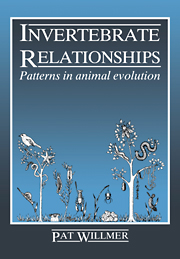Book contents
- Frontmatter
- Contents
- Acknowledgements
- Part I Introduction to animal phylogeny
- Part II Sources of evidence in invertebrate phylogeny
- Part III Phylogeny of major groups
- 7 The origin of the Metazoa
- 8 Acoelomates and other lowly worms
- 9 The pseudocoelomates
- 10 The phylogenetic position of molluscs
- 11 Arthropod phylogeny
- 12 The deuterostomes
- 13 The lophophorates
- 14 A phylogenetic overview of invertebrates
- References
- Index
14 - A phylogenetic overview of invertebrates
Published online by Cambridge University Press: 08 January 2010
- Frontmatter
- Contents
- Acknowledgements
- Part I Introduction to animal phylogeny
- Part II Sources of evidence in invertebrate phylogeny
- Part III Phylogeny of major groups
- 7 The origin of the Metazoa
- 8 Acoelomates and other lowly worms
- 9 The pseudocoelomates
- 10 The phylogenetic position of molluscs
- 11 Arthropod phylogeny
- 12 The deuterostomes
- 13 The lophophorates
- 14 A phylogenetic overview of invertebrates
- References
- Index
Summary
Introduction
Every one of the existing phyla of invertebrates has now been considered, and its relationships to other groups analysed. Some types of animal seem to be very isolated, with little resemblance to and no convincing homologies with any other known forms. Other types of animal appear to be part of fairly clearcut super-phyletic groups, though membership of these is apparently always restricted to a rather small number of phyla. We therefore need only to review the major issues raised by the evidence presented in earlier chapters, and assess critically the existing phylogenetic schemes. It should then be possible to achieve an overview of relationships in the animal kingdom, and to present, somewhat reluctantly, an actual phylogenetic tree of the invertebrates for the sceptical reader to disagree with.
Major issues
Status of the ‘lower’ groups
In respect of complexity of organisation, the ‘lower’ groups of the Metazoa are traditionally the sponges, cnidarians, and ctenophores, together with the placozoans and mesozoans. However, the evidence discussed in chapters 2 and 7 makes it clear that these phyla are not necessarily at all closely related to each other, and in particular that the old super-phyletic groupings of Radiata (as opposed to Bilateria) and of Diploblastica (as opposed to Triploblastica) are unhelpful, inaccurate and eminently worth discarding. Furthermore, most of these ‘lower phyla’ may not be in any sense close to the starting point of animal radiation; no obvious homologies unite them with the rest of the metazoans.
- Type
- Chapter
- Information
- Invertebrate RelationshipsPatterns in Animal Evolution, pp. 350 - 362Publisher: Cambridge University PressPrint publication year: 1990



